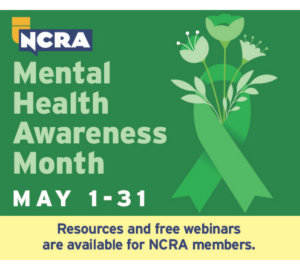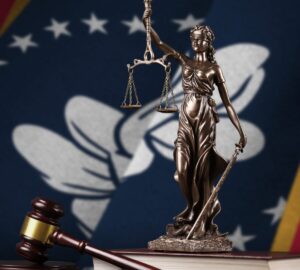By Kellie Smith, RPR, CRR
I am an “old-fashioned stenographer.” That funny looking machine that looks like a cash register to you allows me to write the spoken words you say at 225+ words per minute. The words go in through my ears into my brain where they get translated, very quickly, into another language of sorts, and then that other language comes out through my fingers onto the keys of my cash register – er, steno machine. I do all of this while simultaneously and continuously taking in more information. And yes, I did go to school for this.
It’s called machine shorthand. Picture a piano player playing chords. A stenographer, commonly known today as a court reporter, presses several keys at once to represent an entire word or phrase in one keystroke. This enables us to write faster than typing on a standard QWERTY keyboard. Oh, and our keyboard doesn’t have letters on the keys either.
In 2020, in this electronic age, the digital recording device does just that – records.
I spent my morning preparing a special dictionary for trial. I scoured the witness lists and other trial documents as it is important to me that names are spelled correctly and that they translate for the realtime feed that goes to the judge. Just like the closed-captioning you see on your TV (yes, that’s an old-fashioned stenographer doing that, too), the spoken words I write into my steno machine get translated by my computer-aided software dictionary into English. My judge relies on the realtime feed to assist him during trials.
The digital recorder can’t do any of that. Not even Dragon, no. Have you seen how your iPhone translates your voicemails lately? Can you imagine that in a fast-paced courtroom or deposition? Not only that, voice recognition software cannot distinguish foreign accents and dialects or multiple voices in rapid succession like an old-fashioned stenographer can.
Attorneys, when I saw which table each of you sat at in the courtroom, I told my computer that every time I write this special code on my steno machine, I want it to display your names. I watch you all as you talk, but I also learn your distinctive voices and speech patterns. Your speaker identifications reflect that you, in fact, are the person talking. And you never have to identify yourself as the speaker. I just know it’s you.
The digital recorder relies on you to identify yourself as a speaker, and when you don’t – because who does every time they speak in court? – it’s left up to whoever transcribes that trial months down the road. That human being, who probably doesn’t know you from Adam, has to transcribe that recording while not being able to see you. You might sound quite similar to the other attorney. The decision as to who is speaking will come down to context alone sometimes. And then someone unexpected enters the courtroom and speaks. They will be the unidentified speaker. Helpful.
You were a little soft-spoken today. Did you see me leaning my ear toward you as a hint? I always try to be subtle before I ask you, politely, “Could you speak up, please?” I really do want to report every word you say. I am charged with it. I am a verbatim old-fashioned stenographer.
The microphone wasn’t quite close enough to you and didn’t catch much of what you said, if anything. That compelling argument you made today will be peppered with (inaudible).
I reminded you all to speak just one at a time. I can only report one voice at a time. When you see the transcript, you will be grateful for that request. Dashes sprinkled across the page indicating interruptions do not help the future readers of the transcript.
The digital recording system recorded everyone speaking over each other. It is now indecipherable to the listener and the transcript will read (simultaneous crosstalk).
Someone coughed loudly, and I asked you to repeat yourself because I missed a word. It is important to everyone that the record I make is accurate and complete.
The digital recording system recorded a cough. No one asked you to repeat yourself. The word behind the cough is gone forever. It will be reflected as (inaudible).
I saw you lean over to your client to ask him a question. I could hear it, yes, but I knew this was a privileged conversation that was not part of the record. My hands did not move. I did not report your conversation.
The digital recording system recorded your entire conversation. The human who transcribes it later will transcribe it all because it’s on the recording.
After the judge overruled your objection, the witness needed the question read back. I seamlessly and confidently read the question back for the witness, keeping proceedings on track.
With a digital recorder, it’s going to be mighty difficult to stop the recording and find the correct place in the recording to play back, if it can even be done. And there’s probably nothing quick about that process.
If my equipment happens to malfunction during proceedings, I can immediately stop the proceedings to assess the situation and remedy it. There are no arguments or crucial testimony lost.
At the end of the day with a digital recorder, the operator could realize that the recorder wasn’t even on or the microphones weren’t working, resulting in a lost day of trial or depositions or legislative sessions that can never, ever be replicated in exactly the same way.
When the transcript gets ordered someday, I will carefully edit the transcript, adding correct punctuation, grammar, and spelling. If you cite case law, I will research the citations to make sure they are formatted correctly. That medication the good doctor rattled off at 300 words per minute will be spelled correctly as if my life depends on it. Because I care. I really do. I’m putting my name on that transcript.
With digital recording, you might get a certified old-fashioned stenographer to transcribe it for you, but most likely you won’t. But even the most skilled old-fashioned stenographer can only make garbage look so pretty. We cannot fix after the fact that we cannot hear the judge because her microphone was not on. We can’t help that a door slammed while a party was speaking. The result is something like this:
THE COURT: Well, I have to say (inaudible) agree with (inaudible).
Clear. As. Mud.
So when you think about it, if it was your liberty on the line, your multi-million dollar medical malpractice trial, your child custody dispute, or the legislative record kept on the Senate floor, who – or what – do you want keeping your record? I submit to you that a human being with the gift of discernment, who is trained in this highly skilled profession, should always be your pick.
We aren’t called the guardians of the record for nothing. And that, my friends, is why we still use old-fashioned stenographers!
EU HRO*F PHEU SKWROB STKPWHR FPLT
(I love my job!)
Kellie Smith, RPR, CRR, is an Official Reporter in Puyallup, Wash.





[…] Article from Kellie Smith […]
[…] Old-Fashioned Stenographers: The Real MVPs Share this article in: […]